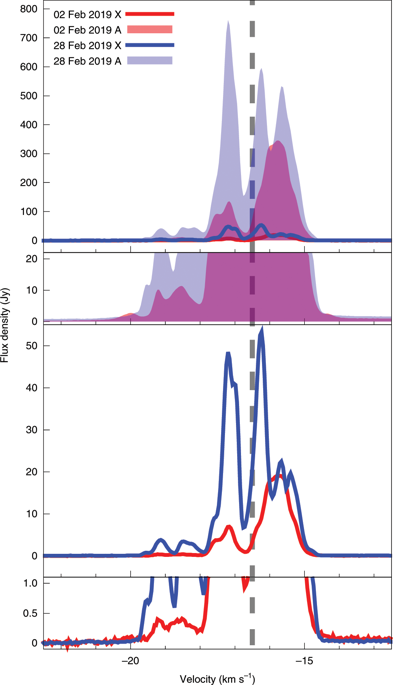Nature Astronomy ( IF 14.1 ) Pub Date : 2020-01-13 , DOI: 10.1038/s41550-019-0989-3 R. A. Burns , K. Sugiyama , T. Hirota , Kee-Tae Kim , A. M. Sobolev , B. Stecklum , G. C. MacLeod , Y. Yonekura , M. Olech , G. Orosz , S. P. Ellingsen , L. Hyland , A. Caratti o Garatti , C. Brogan , T. R. Hunter , C. Phillips , S. P. van den Heever , J. Eislöffel , H. Linz , G. Surcis , J. O. Chibueze , W. Baan , B. Kramer

|
High-mass stars are thought to accumulate much of their mass via short, infrequent bursts of disk-aided accretion1,2. Such accretion events are rare and difficult to observe directly but are known to drive enhanced maser emission3,4,5,6. In this Letter we report high-resolution, multi-epoch methanol maser observations toward G358.93-0.03, which reveal an interesting phenomenon: the subluminal propagation of a thermal radiation ‘heatwave’ emanating from an accreting high-mass protostar. The extreme transformation of the maser emission implies a sudden intensification of thermal infrared radiation from within the inner (40-mas, 270-au) region. Subsequently, methanol masers trace the radial passage of thermal radiation through the environment at ≥4% of the speed of light. Such a high translocation rate contrasts with the ≤10 km s−1 physical gas motions of methanol masers typically observed using very-long-baseline interferometry (VLBI). The observed scenario can readily be attributed to an accretion event in the high-mass protostar G358.93-0.03-MM1. While being the third case in its class, G358.93-0.03-MM1 exhibits unique attributes hinting at a possible ‘zoo’ of accretion burst types. These results promote the advantages of maser observations in understanding high-mass-star formation, both through single-dish maser monitoring campaigns and via their international cooperation as VLBI arrays.
中文翻译:

由 G358-MM1 大质量原恒星中的脉泽追踪的吸积能量热浪
大质量恒星被认为是通过短暂的、不频繁的盘状吸积1,2爆发来积累大部分质量的。这种吸积事件很少见且难以直接观察到,但已知会驱动增强的脉泽发射3,4,5,6. 在这封信函中,我们报告了对 G358.93-0.03 的高分辨率、多纪元甲醇脉泽观测,揭示了一个有趣的现象:从吸积的高质量原恒星发出的热辐射“热波”在腔内传播。脉泽发射的极端转变意味着来自内部(40-mas,270-au)区域内的热红外辐射突然增强。随后,甲醇微波激射器以≥4% 的光速追踪热辐射在环境中的径向通道。如此高的易位率与≤10 km s -1甲醇微波激射器的物理气体运动通常使用超长基线干涉仪 (VLBI) 进行观测。观察到的情景可以很容易地归因于高质量原恒星 G358.93-0.03-MM1 中的吸积事件。G358.93-0.03-MM1 虽然是同类中的第三个案例,但表现出独特的属性,暗示可能存在吸积爆发类型的“动物园”。这些结果通过单碟脉泽监测活动和通过它们作为 VLBI 阵列的国际合作,促进了脉泽观测在了解大质量恒星形成方面的优势。


























 京公网安备 11010802027423号
京公网安备 11010802027423号